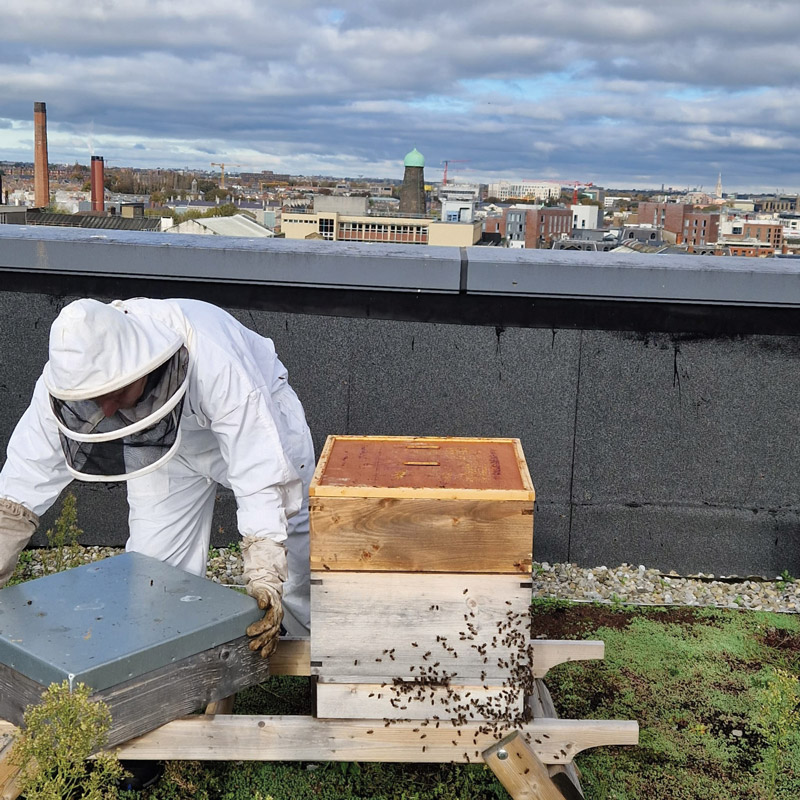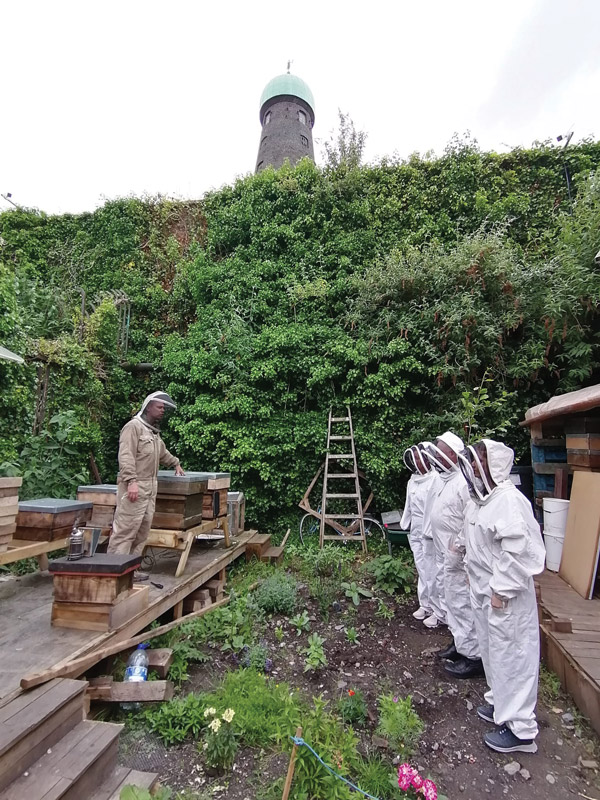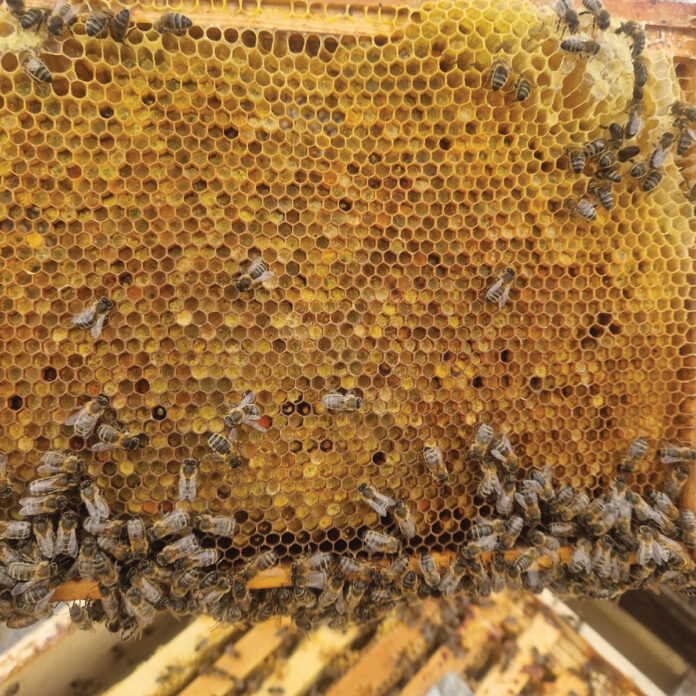Bee8 – an inner city beekeeping project – is an environmentally and socially sustainable social enterprise managed by Dublin 8’s Robert Emmet Community Development Project (CDP), an organisation working to build a sustainable, thriving, inclusive community in the south-west inner city.
Robert Emmet CDP run Bee8 in partnership with The Digital Hub, a leading cluster of technology and digital media companies and creatives, managed by an Irish state agency and located on Thomas Street in Dublin’s inner city. The Digital Hub facilitates and contributes to urban regeneration in the Liberties area.
A core objective of Bee8 is to create a network of pollinator-friendly spaces across Dublin. This includes the establishment of urban beehives, pollinator gardens, and green roofs, all designed to support bee populations and other pollinators essential for ecosystem health.
The project also emphasises sustainable practices and aims to educate the public about the importance of bees. Local schools, businesses, and community groups are involved in beekeeping activities, learning about the crucial role bees play in pollination and food production.
Pollinator gardens are planted with a variety of flowering plants, providing nectar and pollen for bees and other pollinators throughout the year. By transforming underutilised urban spaces into vibrant gardens, Bee8 enhances biodiversity and beautifies the city.
Green roofs and living walls are innovative solutions that Bee8 promotes to increase urban greenery.
LINKS WITH SMART TECHNOLOGY
Bee8 have expanded the scope of our beekeeping initiative to incorporate smart technology to monitor air quality, pollination pathways, pathogens and other important environmental metrics across Dublin 8. This has been achieved through the integration of 22 tiny innovative sensors into 60 beehive sites. Bee8 aims to improve people’s well-being through bees. By integrating sensors into beehive sites, urban environment quality is measured as exemplified by the bee population’s health.
The goal is to capture, using the sensors, local air quality and CO2 levels, creating a feedback loop between the local residents and the hive managers as to the impact on Dublin 8’s biodiversity.
 BENEFICIARIES OF THE PROJECT
BENEFICIARIES OF THE PROJECT
Local communities in Dublin gain greener, more aesthetically pleasing neighbourhoods, and the educational programmes associated with Bee8 raise awareness about environmental issues and encourage community involvement in sustainability efforts. Bee8 collaborates with schools and educational institutions to integrate beekeeping and pollinator education into their curricula. This hands-on approach helps students learn about biology, ecology, and the importance of the environment.
Local businesses that partner with Bee8 enjoy enhanced corporate social responsibility (CSR) profiles. Participating in sustainability initiatives can improve a company’s reputation, attract eco-conscious customers, and boost employee engagement.
For professionals in the horticulture industry, Bee8 provides a model for integrating biodiversity and sustainability into urban landscapes. By adopting similar sustainable practices – such as incorporating native plants, reducing pesticide use, and creating diverse planting schemes – horticulturists can contribute to environmental conservation while enhancing their business operations.
Promoting green infrastructure through features like green roofs and living walls presents significant opportunities for the horticulture industry. These elements can be integrated into residential, commercial, and public buildings, offering new business avenues for horticulturists while contributing to urban sustainability.
By transforming underutilised urban spaces into vibrant gardens, Bee8 enhances biodiversity and beautifies the city

SUSTAINABLE URBAN HORTICULTURE
The Bee8 project in Dublin serves as an inspiring example of how urban areas can champion sustainability and biodiversity. By embracing sustainable practices, promoting biodiversity, and engaging with their communities, horticulturists can lead the charge toward a greener, more sustainable future. Through collective efforts and innovative thinking, the horticulture industry can help create thriving urban environments that benefit people, pollinators, and the planet.

ALISON FERNANDES is Social Enterprise Manager at Robert Emmet CDP, a community development project dedicated to improving the lives of local residents through various initiatives. In Bee8, she manages the implementation and sustainability of the beekeeping project. alison@recdp.ie
INSPIRING GREEN CITIES
BY ANTHONY FREEMAN O’BRIEN, OPERATIONS MANAGER AT ROBERT EMMET CDP
I grew up in Dublin’s inner city. Dublin 8 was and still is completely underserved with green infrastructures. This leaves us with the highest emissions in the city. Air quality is much poorer than the rest of the city as there are very few natural buffers to emissions, such as trees and other green natural carbon filters.
I’m the main beekeeper for our beekeeping project, Bee8. One of my first spaces was a site on Watling Street, which once held the water tank for the old whiskey distillery. The Digital Hub gave us this derelict space for some beehives. The space was overgrown with weeds and there were discarded drug needles and beer cans streamed all over the place, but all I could see was its potential. It was full of plant life, so I knew I could turn it around.
I approached Digital Hub with a proposal to turn the site into a mindfulness garden, and they accepted. I cleaned it all out, dug up most of the plants and put in new beds. I also painted the walls and tried my best to match the colour to the sky so it felt like the space was a meadow in the middle of the city. We now use this space for educational purposes, teaching about honey bees and biodiversity.
A big goal of ours is the greening of rooftops, so it was very interesting to learn that Copenhagen has passed a new law that all new buildings with rooftop slopes of less than 30 degrees will have to be green. Bicycles are the most common form of transport in Copenhagen. In 2016 there were 675,000 bicycles and just 120,000 cars on the streets. Copenhagen hopes to be carbon neutral by the year 2025. In the city, organic food makes up 24 per cent of all food sales, and 88 per cent of food eaten in the city’s institutions is organic. Around a quarter of the urban area of the city is green space, meaning each person living there has an average of 42.4 sm at their disposal – in stark contrast to the 0.7 sm we have here in the Liberties.
Stockholm has biofuel available at every fuel station, generated from sewage. They are also working with the energy company, Fortum, to create a city-wide heating system, using the heat generated from data centres, supermarkets and stadiums to provide heat for residents around the city.
Vancouver is striving to be considered the greenest city in the world. Their city council has set out a target of 100 per cent renewable energy by 2050, and already they are close to reaching this goal. Over 95 per cent of Vancouver’s electricity is supplied by renewable energy. Over 90 per cent of people in Vancouver live within a 5-minute walk of green space, and 18 per cent of the city is urban forest. The goal is that all travel in the city by 2040 will be by walking, cycling or public transport.
Berlin is literally one of the greenest cities on earth, with more parks, gardens and forested areas than any other city. Over 30 per cent of the city is green, and there is a thriving allotments culture.
The cities of the future are full of great and wondrous opportunities for society to move forward in a sustainable manner. There are inspiring projects all over the world that fill me with positivity in what we can achieve, not only for the climate crisis, but for our own sanity living in cities.
Stockholm has biofuel available at every fuel station, generated from sewage




